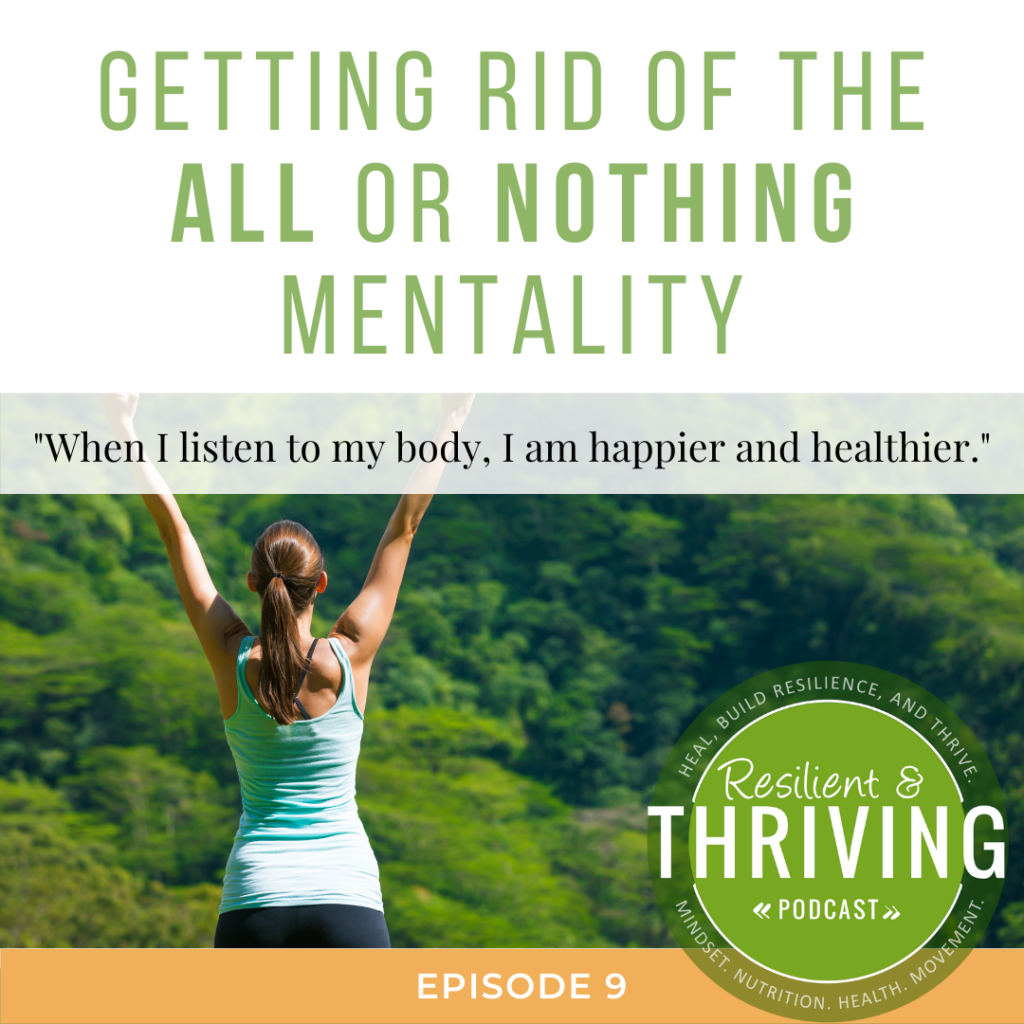Getting Rid of the All or Nothing Thinking & Making Change with Ease – EPISODE 9

I think I could safely say that most of us have come face-to-face with the all-or-nothing thinking mentality. And especially with our health.
As you know, I’m a holistic health coach and a running coach. I’ve seen this in both sets of clients over and over again, especially with those who live busy and full lives. Maybe it’s because it’s a battle I’ve wrestled over time. Maybe it’s cultural. But I believe I’ve found a lot of breakthroughs here over time as I’ve realized that swinging the pendulum from one end of the other doesn’t end up working long term.
So I’m excited to share with you today some helpful insights, as well as some practical steps towards moving forward towards your health goals with ease. Stay to the end.
Most people I know have gone after one diet or training program that have had an all-in approach. Shortly after that program, they enter a time of not doing any of those lifestyle elements at all. So what happened? Was it worth it?
I remember one time I was trying to build running back into my life after a long break. I’d train for a 5K, then take a month or two off. Then when I’d start back up again, I was starting from scratch. All that training I’d built was nearly gone. Then one day, after doing this 3-4 times, I realized that if I just started considering training as a part of my every day life, I’d continue to improve, then of course I’d enjoy it more, and I wouldn’t have to restart and hate the beginning process.
Then, shortly after, I had a client tell me they weren’t making any progress with their workouts. We discussed what they were doing and they’d workout 2 hours at once, then not at all for several days. They might get in 1-3 workouts per week. But they figured that their hard workout was so challenging that it should be doing something, right?
Actually, no. It’s actually MUCH better to take small steps that you CAN do over the long haul. Think about it. Your life can only handle so much. But if you can actually sustain it, you can do more and more because you’ll build even more capacity as you go along.
Recognize Every Change Takes Time & Needs to Be Integrated
Just like I had a challenging time when I’d start training for my 5Ks, every change that we implement into our lives takes time to get used to, to build a habit around, to welcome into our lives, and to become more natural. But once I built up to the 5K, got through the pain of being out of shape, and created consistency in my life, I found that running became fun, it became a lot easier, and I looked forward to it. It also wasn’t something I had to think about anymore. I was in the habit of laying out my clothes at night, so when I woke up, things were ready for me to go.
The same thing happened when I introduced eating healthy, home-cooked meals into my life. That wasn’t something I knew how to do and it actually caused me quite a bit of panic at first. It was overwhelming. I had NO idea how to do that. So I started with just 1 meal per week, rather than trying to overhaul my entire diet and lifestyle.
All or nothing thinking is a type of cognitive distortion where you live with one extreme or another. You feel that either you do something perfectly, or not at all. Either I’m all in or I’m not touching it.
And in the end, this can lead to issues throughout your life, including when it comes to the way you eat and living a healthy lifestyle. For example, hard core restricting of foods OR binge eating anything can both lead to a host of health issues. And similarly, training really hard continually OR not moving your body at all can also result in major health and lifestyle issues.
So what’s the idea? You will find something right in the middle of this, is balance, health, and living intuitively.
You’re Human. Nobody is Perfect All of the Time
If you keep getting caught up in the all-or-nothing thinking, something to remember is that being perfect all the time isn’t something anyone can achieve.
You are a human being, and that comes with having a lot of good days, and some bad days. Nothing is black and white, so if you have this thinking, it is only going to lead to feelings of negativity, guilt, shame, and frustration.
This Leads to Yo-Yo Dieting, Disordered Eating, or Burnout
The all or nothing is not only damaging to your mental health, but your physical health as well. If you have trouble with dieting and binging, or any type of disordered eating, it might be partially from this black and white way you live your life.
When you start thinking in all or nothing as it related to food and dieting, it often means you are either on a restrictive diet, or you are overeating/binging to the point of being sick. If this sounds like you, it is this very attitude that is holding you back. You feel like if you eat a cookie for a snack, you just blew your diet, so you might as well eat the rest of the dozen. Then you experience shame and guilt, followed by more binging, for days or weeks until you start restricting again.
See the problem?
Making Small Habit Changes for Sustainable Change
Helps to Get Rid of This Mentality
Intuitive living is a great way to start to think about balance and moderation, as opposed to all or nothing. It promotes just living your life and striving for fulfillment and satisfaction. Through eating intuitively, you don’t follow a diet, you don’t count calories, and you don’t wear a fitness tracker.
Instead, you eat when you’re hungry, stop when you’re full, enjoying the environment you’re in, focus more on mindfulness and how you feel, and don’t limit anything from your diet. You move your body regularly, but not under punishment or overworking it. You rest when you need to and you listen to how your body is doing.
You also take small steps towards your goals and integrate them into your life, while building bit-by-bit until you get there. If the steps are too big, you break them down into even smaller pieces, but you don’t overhaul it altogether.
So, how do you really do this?
Activity Steps
- Write out the dreams and goals you have for your life. Why do you want these? Get in touch with this part first.
- Then write out the first few steps you’ll need to take to get there. You don’t need the full picture.
- Then pause and realistically look at what you can begin adding to your life today, this week.
Ask yourself: Is it realistic? Is it encouraging? Is it leading you to your ultimate goal? Can you do build this 1 step into your lifestyle? What would it take to actually build it into your life as a lifestyle? What mindset shifts and beliefs would you need to change? - And then schedule it into your life for the next 2 weeks.
- Realign your heart on a regular basis on why you’re doing it by looking back at your answers to the first question of what your goal is and why you want it.
- And when you’re ready, come back to the list you made, and look at what one more step you can add in might be. Begin to add that into your life along with the previous one.
This is habit stacking. You’re adding one in after the other. But not all at the same time. You’re creating intuitive lifestyle changes without swinging the pendulum from one end to the other. If you pay attention, you’ll see far more change than you realize!

